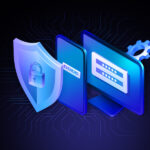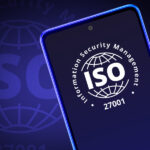Why does your company need a mobile device management solution?
Why does your company need an MDM solution?
Mobility in business began with the era of laptops, which unprecedentedly displaced desktop units. The year 2020 started an increased demand for mobile devices in business and the home, which has become the workplace for most of us. Today, over four times as many cell phones are sold worldwide as computers. At the end of 2022, 301 million smartphones[1] hit global markets. In the same period, we bought only 67.2 million computers[2]. Cell phones are undeniably the leading tool for business, carrying hundreds of millions of information that must be secured.
Mobility has become a challenge for large companies that manage multiple types of devices (desktops, laptops, tablets, smartphones, rugged devices, or wearables) and smaller players whose employees use their devices in a BYOD model. Companies are also increasingly moving their infrastructure to the cloud (Eurostat: 2016 – 19% of EU companies, 2021 – 42% of EU companies[3]), giving employees access to applications, data, and other resources, from anywhere and on any device. Companies have become mobile but also flexible.
Unfortunately, with them came more cyber threats, and device management responsibilities have expanded. These challenges make implementing mobile device management (MDM) solutions crucial for any enterprise today.
What tasks does the MDM system perform?
MDM is a mobile device management tool, in its expanded version known as EMM system – for enterprise mobility management, and in its most expanded version as UEM, or unified endpoint management.
Each is designed to apply a consistent configuration to every device. Due to this, every user gets the same tools to work with, the IT team solves problems faster and provides better support, and the company gains security. In three words: MDM makes everyday work more accessible, efficient, and secure.
It uses an MDM agent and a configured MDM server, either on-premises or in the cloud, to deploy policies to the device. Initial settings and updates are delivered to the device remotely, so the user does not have to perform any action. Hence, at the first launch of a business device, an employee may have to set a configuration according to our rules – a password or not being able to download specific applications, for example, for social media.
What benefits can you expect from implementing a mobile device management solution?
Simplify management and improve performance.
Managing a fleet of ten of the same devices on which you don’t need to install additional applications or security features – seems pretty straightforward. Driving the same number of devices in a situation where each is different, scattered all over the country, requires installation of several company applications, and has other ownership statuses – can be challenging. It’s worth further imagining managing a hundred such devices, a thousand, and so on. Every organization should have remote and easy access to its devices and their locations; the data processed on them; security reports; device and application configuration; or remote support. Without an IT team is only possible with the help of a centrally managed MDM system.
Cost reduction
The MDM platform reduces IT staff’s time and effort administering company devices. Automating many time-consuming processes involved in monitoring or updates frees human resources that can include in more advanced and creative projects, such as those with artificial intelligence implementations. On the other hand, it allows a minor team to handle the growing number of devices.
Using an appropriate policy in Device Owner mode makes it possible to disable data roaming completely. It is also possible to impose a policy on selected applications that prohibits data usage upon entering or leaving a specific area, such as a country or EU zone. Thus, the company gains a tool to secure its funds against accidental or unwanted data downloads in places where the cost of 1GB transmission can cause no small surprise.
BYOD support
Bring your own device is an increasingly popular management model in organizations. It’s cheaper for the company because it doesn’t require buying a wide range of instruments and paying for telecommunications services. It allows each employee to work on the equipment that suits them best and not have to carry two smartphones with them throughout the day.
A key feature in securing sensitive corporate data for BYOD devices is containerization. This feature isolates company data and applications from the private zone. Thus, it protects against attacks, risky user actions, and even unintentional actions that could cause damage to the organization. Companies don’t have to choose between security and employee freedom.
Application control
The MDM console allows the secure distribution of applications from a managed application store or a file. The system enables the safe distribution of applications from an operated store or a file. Administrators can prepare a list of permitted applications and block those we don’t want to give access to our employees. Admin can also maintain the latest version of company applications. The system allows you to choose how to update your data so that it does not cause excessive data transmission consumption. Moreover, it enables you to impose automatic updates of company applications to their latest version regardless of whether a tariff connection is currently selected on the device.
Safety and regulatory compliance
Remote management, automation, control, or implementation of security policies undoubtedly enhances any organization’s security. An administrator can monitor, update and troubleshoot a device in real-time. A good MDM lets you lock or wipe a device remotely if lost or stolen. These features make MDM an invaluable tool for meeting compliance and regulatory requirements such as GDPR, ISO/IEC 27001, or SOC 2.
What to follow when choosing an MDM solution?
The number of solutions we can get on the market is enormous. It is often difficult to compare them 1:1, so it is worth focusing on the most critical elements for our organization.
Price
MDM systems are distinct in price, which depends on many factors. Treating it as the only starting point in the search for suppliers, we may overlook its essential components. When comparing offers, it is worth paying attention to the following details:
- the type of access – whether under the license you get access to the full functionality of the system or only to part of it;
- applications – whether all applications necessary for the functioning of the system (e.g., MDM agent), as well as additional ones, are offered free of charge;
- the duration of the contract and the monthly cost;
- the number of devices you can deploy as part of the solution.
Fancy features
A longer list of the system’s functionalities will enable us to tailor it to our needs better. It is good to start by writing down our expectations and verifying them with the selected offering. A more expanded MDM system can provide us with functions we hadn’t thought of before, allowing us to develop our business, such as the kiosk mode, which launches a new outlook on mobile devices. In organizations implementing a more thoughtful policy, it is worth noting the possibility of developing the system under our company’s needs. Solutions that the manufacturer provides for cooperation with its customers in developing new functions gain invaluable added value.
Documentation and certificates
Verifying the documentation and specifications of the system is a crucial step. It is essential to pay attention to manufacturer assurances and check whether the chosen solution does not abuse the capabilities of third parties, such as Google. It happens that manufacturers bend restrictions and legal integration capabilities. Unfortunately, the end users are beneficiaries of such abuses, who may have to bear the costs associated with the sudden exclusion of functions implemented in violation of regulations.
When choosing a vendor, you should pay attention to User Privacy, a vital issue for the BYOD model. In it, private data should even be untouched by external software. Any abuse the system manages the device can commit against the user’s privacy should be unacceptable, and functions that can do so should be blocked in the BYOD model. A sound MDM system adheres to any standards adopted by Google or Apple in this regard and does not, under any circumstances, violate user privacy. Of course, if the device owner, in this case, an employee, allows extended protection, it is also worth enabling it in the private part. But such a solution cannot be treated as a standard, as it violates the user’s privacy.
MDM is a recommended tool for the implementation of ISO and GDPR issues. Transferring the responsibility for the correct fulfillment of the requirements, it is worth choosing a supplier with the necessary certifications, as only they give us objective compliance assurance.
Licensing models
With the evolution of the architecture, most MDM solutions became available in a cloud version. This solution is now one of the more favorable licensing models. In contrast, more than half of the companies in the EU do not use this type of solution[3]. It is worth verifying whether the vendor’s offering includes an On-Premise license, which is required for critical services that are impossible or uneconomical to migrate.
Technical support
An MDM solution, like any other software, requires technical support. However, it can vary significantly, depending on the services offered. It is worth analyzing the following issues:
- whether the manufacturer provides support throughout the purchasing process, during implementation, and after the sale;
- whether the implemented support is available as part of the license or for a fee;
- whether the manufacturer offers extended paid support that can fit our company’s needs;
- what communication channels are available – email, chat, service queue, and what are the hours of operation of the support provided by the vendor;
- what is the language of the services provided;
- whether we get access to the knowledge base and other educational materials as part of the license;
- whether the vendor offers training services for administrators.
No time for reading – listen to our podcast.
Grab some knowledge with Proget – check out some of our other articles:
- Cyber hygiene in business – learn the simple rules and how you can support it
 Cyber security is an important element of trust both in and within an organization. This is especially true at a… Czytaj więcej: Cyber hygiene in business – learn the simple rules and how you can support it
Cyber security is an important element of trust both in and within an organization. This is especially true at a… Czytaj więcej: Cyber hygiene in business – learn the simple rules and how you can support it - Why choose a vendor that is ISO 27001 certified?
 What is the standard and ISO 27001 certification? ISO/IEC 27001 is an international standard for information security management that defines… Czytaj więcej: Why choose a vendor that is ISO 27001 certified?
What is the standard and ISO 27001 certification? ISO/IEC 27001 is an international standard for information security management that defines… Czytaj więcej: Why choose a vendor that is ISO 27001 certified?
Data source:
[1] Counterpoint Research Quarterly Global Smartphones Shipments data, Q3 2022
[2] IDC Top 5 Companies, Worldwide Traditional PC Shipments, Q3 2023
[3] Eurostat, Use of cloud computing in enterprises in 2021
